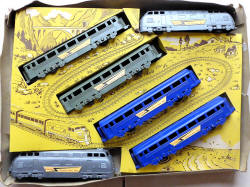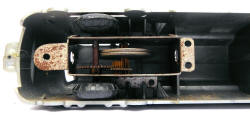Colin says: it should be noted that I have collected these vehicles
for close on fifty years as they play an important part of the
railways story as many of them were used to illustrate catalogues
and box lids, as well as being used as wagon loads in both the UK,
Canada, and New Zealand. The series I am referring to is known as
the OOO series, and this would suggest, to some, a smaller gauge,
but they are in fact closer to OO/HO. The use of plastics by Tri-ang
for the Minic ranges dates to 1948 but the OOO series seems to have
first come onto the scene in 1954. The range at that time was about
fourteen vehicles which consisted of a double decker London bus a
coach and a forward control 4-wheel lorry with twelve different body
styles. All the lorries had a red cab/chassis, and the body styles
were in contrasting colours (most being various shades of blue,
green, yellow, cream and grey). All vehicles initially had a small
metal hub with separate rubber tyres. Actual dates are difficult to
establish, but my estimate is that minor changes to the mouldings
were made over a number of years. The first change around 1955
appears to be the removal of the metal hub and all lorry wheels now
have a solid rubber wheel, though for some unknown reason the bus
and coach retained the metal hubs throughout their production. I
believe that around 1956, the four saloon cars, and the articulated
mechanical horse and its various trailers appeared together with the
tank, armoured car, bulldozer, and crane. These all have solid
plastic front wheels/axels, and I have never seen any with the metal
hubs however the solid rubber tyres were used on the axel for the
Push & Go motor, which they retained throughout their production. On
or around 1957 six trailers were made for six of the lorries and
this required the fitting of a towing eye on the rear of the lorry
chassis. This required modifications to the body casting of both the
fire engine and dustcart as they overhung the rear of the chassis. I
believe that at the same time the front wheels on the lorries were
changed for the plastic version as these are now a push fit, rather
than having a separate metal axel. Also, around this time the three
presentation sets are produced, and this gives us a new addition to
the civilian lorries being the radar dish in red with a yellow
control cabin. Also, in the RAF and Army Presentation Sets the coach
now has four solid rubber wheels. There are also a couple of models
that are very seldom seen, these are the log trailer to go with the
bulldozer and the crane with excavator bucket. There are also a
couple of promotional models for Seven-Up and toothpaste. Most
vehicles were individually boxed and some small sets containing six
or eight vehicles, however many were also sold loose from counter
packs containing twelve or more models of the same type.
Three pictures show the progression from metal hubs to plastic front
wheels together with the modifications for the wheels and towing
eye. I am not able to explain why some of the later models with
plastic front wheels do not have the towing eye, other than,
perhaps, there was more than one shot in the mould and only one shot
was modified with the towing eye. The other two pictures show the
modifications to the rear of the fire engine.
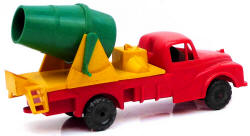
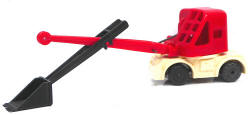
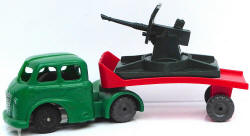
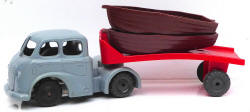
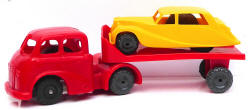

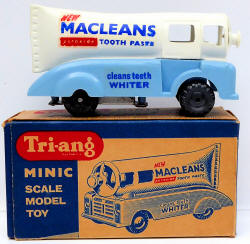
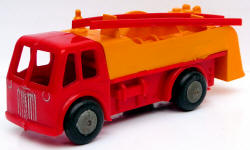
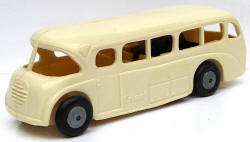
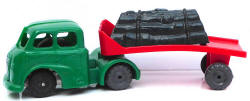

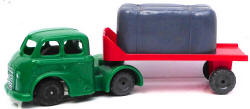
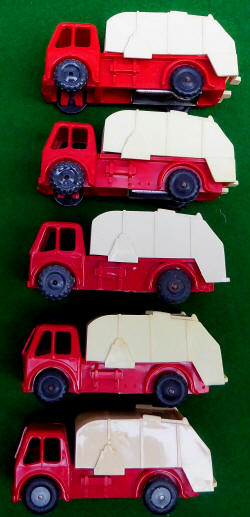
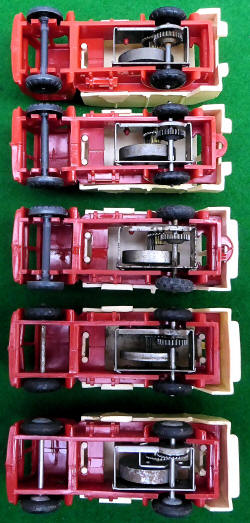

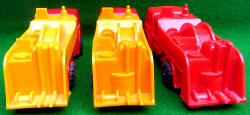
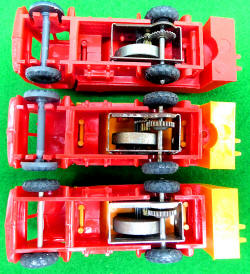
Colin says: At one of last year’s train shows I
picked up what may be a Spanish version of the Tri-ang Twin Train Set,
It has no markings so presume the Tri-ang logos were removed from the
moulds and this set was produced after some of the moulds (mainly
Big-Big) were sold to NOVA. Sadly there was no lid to the box, so I
could not gain more information, however it can be seen that the box
style is identical to the Tri-ang version, but in a much cheaper card
and even the artwork on the inner tray is very similar. The main
difference is that the American style locomotive has been replaced with
a European style locomotive, the construction and rubber wheels used is
very much in the Tri-ang style, if anybody can shed further light on
this set please do.
